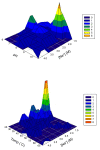Biodiversity of poly-extremophilic Bacteria: does combining the extremes of high salt, alkaline pH and elevated temperature approach a physico-chemical boundary for life?
- PMID: 19930649
- PMCID: PMC2785825
- DOI: 10.1186/1746-1448-5-9
Biodiversity of poly-extremophilic Bacteria: does combining the extremes of high salt, alkaline pH and elevated temperature approach a physico-chemical boundary for life?
Abstract
Bacterial microorganisms that grow optimally at Na+ concentrations of 1.7 M, or the equivalent of 10% (w/v) NaCl, and greater are considered to be extreme halophiles. This review focuses on the correlation between the extent of alkaline pH and elevated temperature optima and the extent of salt tolerance of extremely halophilic eubacteria; the focus is on those with alkaline pH optima, above 8.5, and elevated temperature optima, above 50 degrees C. If all three conditions are required for optimal growth, these microorganisms are termed "poly-extremophiles". However, only a very few extreme halophiles able to grow optimally under alkaline conditions as well as at elevated temperatures have been isolated so far. Therefore the question is: do the combined extreme growth conditions of the recently isolated poly-extremophiles, i.e., anaerobic halophilic alkalithermophiles, approach a physico-chemical boundary for life? These poly-extremophiles are of interest, as their adaptive mechanisms give insight into organisms' abilities to survive in environments which were previously considered prohibitive to life, as well as to possible properties of early evolutionary and extraterrestrial life forms.
Figures


References
-
- Oren A. In: The Prokaryotes. A Handbook on the Biology of Bacteria: Ecophysiology and Biochemistry. Dworkin M, Falkow S, Rosenberg E, Schleifer K-H, Stackebrandt E, editor. Vol. 2. New York: Springer; 2006. Life at high salt conditions; pp. 263–282.
-
- Mesbah NM, Hedrick DB, Peacock AD, Rohde M, Wiegel J. Natranaerobius thermophilus gen. nov., sp. nov., a halophilic, alkalithermophilic bacterium from soda lakes of the Wadi An Natrun, Egypt, and proposal of Natranaerobiaceae fam. nov. and Natranaerobiales ord. nov. Int J Syst Evol Microbiol. 2007;57:2507–2512. doi: 10.1099/ijs.0.65068-0. - DOI - PubMed
-
- Mesbah NM, Wiegel J. In: Incredible Anaerobes: from Physiology to Genomics to Fuels. Wiegel J, Maier RJ, Adams MWW, editor. Boston: Blackwell Pub. on behalf of the New York Academy of Sciences; 2008. Life at extreme limits: the anaerobic halophilic alkalithermophiles; pp. 44–57. - PubMed
-
- Mouné S, Manac'h N, Hirschler A, Caumette P, Willison JC, Matheron R. Haloanaerobacter salinarius sp. nov., a novel halophilic fermentative bacterium that reduces glycine-betaine to trimethylamine with hydrogen or serine as electron donors; emendation of the genus Haloanaerobacter. Int J Syst Evol Microbiol. 1999;49:103–112. doi: 10.1099/00207713-49-1-103. - DOI - PubMed
-
- Fendrich C. Halovibrio variabilis gen. nov. sp. nov., Pseudomonas halophila sp. nov. and a new halophilic aerobic coccoid Eubacterium from Great Salt Lake, Utah, USA. Syst Appl Microbiol. 1988;11:36–43.
LinkOut - more resources
Full Text Sources

